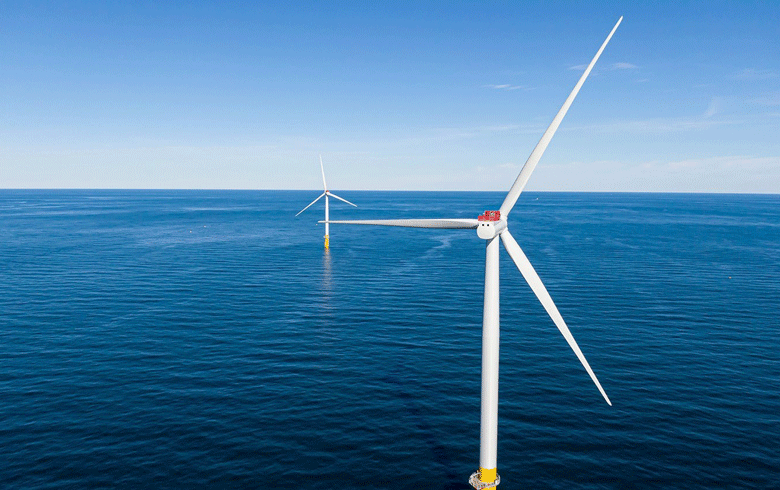Scheduled to begin construction in 2024, the Coastal Virginia Offshore Wind project launched by Dominion Energy is the largest of its kind in the country. A 2.6-gigawatt wind farm that will consist of 176 wind turbines, each standing at around 800-feet tall 27 miles off the Virginia coast, the project also includes three offshore substations that collect the energy, undersea cables to shuttle it to land, and new onshore transmission infrastructure.
Dominion, a private American power and energy company, has marketed the project as good for business, claiming that states that opt-in early to offshore wind will remain at the forefront of a growing and rapidly changing energy sector, attracting investment and propelling economic growth. The wind farm will create 1100 jobs once it is fully constructed.
The pair of wind turbines currently in operation by Dominion on the site are the first installed in U.S. federal waters and are collectively displacing up to 25,000 tons of carbon dioxide emissions annually.
The project will likely be the first of many of its kind along the East Coast.
Large offshore wind projects will require substantial upgrades to existing onshore grids…
In October, the U.S. Department of Energy pledged to generate 30 gigawatts of offshore wind energy by 2030. At the same time, the Department of the Interior also proposed a lease sale for wind energy development off the shores of the Carolinas and demonstrated interest in development in the waters of Massachusetts and the Gulf of Mexico.
This investment in wind energy is baked into the DOE’s push to meet the Biden Administration’s goal of 100% carbon-free electricity by 2035 and a net-zero emission economy by 2050. It doesn’t come without complications.
A challenge for the offshore wind industry will be ensuring viable transmission, or the process by which electricity is transported from the generating site to its consumers. Large offshore wind projects will require substantial upgrades to existing onshore grids, which currently are unable to support the amount of proposed energy coming onshore.
Further, much of the port infrastructure along the coast will need to be overhauled in order to provide adequate assistance on the oft-forgotten shore-side of offshore energy. The U.S. Department of Transportation’s Maritime Administration announced $230 million in funding for port and intermodal infrastructure-related projects.
The tangle of local, state, and federal jurisdictions that manage these types of projects further complicates the future of offshore wind energy. On the federal side alone, there are 26 agencies with authority over different aspects of ocean waters and resources. At the same time, states control coastal waters out to three nautical miles.
But beyond this bureaucratic complexity that makes it difficult to get projects approved, proposed offshore wind projects in the U.S. have faced strong dissent from opposing stakeholders. In Maine, the loudest voices are primarily from commercial fishermen concerned about impacts on fisheries and on fishing rights.
“The Gulf of Maine has some of the strongest winds in the world, and Maine has among the most accessible deep-water ports on the East Coast,” said Anthony Ronzio, deputy director of Gov. Janet Mills’ Office on Policy Innovation and the Future. Ronzio notes that this, in combination with Maine’s manufacturing base and a workforce already adept in maritime fields, could lead to economic growth for the state as it stretches to meet its own ambitious clean energy and climate change goals.
By exploring opportunities for thoughtful development in the Gulf of Maine and determining how to best position the state to benefit from an industry expected to generate $1 trillion in global investment by 2040,” Ronzio said, “we believe offshore wind can generate lasting economic investment.”
Still, in July, Mills signed into law a measure that prohibits new offshore wind projects in state waters. The move was a compromise with commercial lobster fishermen who are at work in an industry already under immense economic pressure due to the impacts on fisheries from increasingly warm seas.
Even with state waters protected for now, fishermen remain concerned about what they see as the potential industrialization of the Gulf of Maine. Projects coming down the pipeline require underwater cables to connect wind farms in federal waters to the Maine shore, disrupting traditional fishing access to the bottom.
Deliberations between the government and groups like the Maine Lobstermen’s Association resulted in the creation of a new Offshore Wind Research Consortium that includes representation from Maine’s fishermen.
The concern expands beyond the Maine shore and hasn’t gone unheard. The DOE and the Department of Commerce announced a new partnership through the Northeast Sea Grant program that will fund research into the impacts of ocean-based clean power (soon we’ll be talking about tidal energy) on the fishing industry and broader Northeastern coastal communities.
While responding to concerns from the fishing industry, Mills’ move retains the option for future wind power development in offshore federal waters, which will more than likely be the trend along the East Coast as the federal government continues to pump cash into renewable energies.





